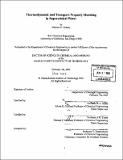Thermodynamic and transport property modeling in super critical water
Author(s)
Kutney, Michael C. (Michael Charles)
DownloadFull printable version (74.31Mb)
Other Contributors
Massachusetts Institute of Technology. Dept. of Chemical Engineering.
Advisor
K.A. Smith and J.W. Tester.
Terms of use
Metadata
Show full item recordAbstract
Supercritical water oxidation (SCWO) is a thermally-based, remediation and waste-treatment process that relies on unique property changes of water when water is heated and pressurized above its critical point. Above its critical point (374.1 ⁰C and 220.9 bar), water becomes gas-like and somewhat non-polar due to the decrease in density and disruption of the hydrogen-bond network. When oxidants and organic compounds are combined with supercritical water (SCW), they rapidly form a single phase, and these organics are quickly and completely oxidized to simple molecules including water and carbon dioxide. Laboratory research is currently being conducted in order to increase the level of understanding of key SCWO areas including reaction kinetics, corrosion, and salt-related phenomena and in order to develop realistic SCWO process and fluid-dynamic simulators. Understanding the phenomena in each of these areas requires accurate thermodynamic- and transport-property predictions. However, these often do not exist. Furthermore, available correlations are often used in operating regimes where they were not originally validated, thereby potentially reducing their accuracy. This thesis focuses on the development of accurate thermodynamic-property and diffusivity- transport-property models for use at typical SCWO operating conditions, namely 25 ⁰C =/< T =/< 650 ⁰C and 1 bar =/< P =/< 300 bar, along with the measurement of molecular diffusivity, an important transport-phenomena property. These models can be incorporated into simulation tools which are used to model SCWO processes or physically simulate the flow, kinetics, corrosion, salt nucleation, and salt precipitation inside SCWO reactors. (cont.) These large-scale SCWO simulations should ultimately lead to improved reactor designs which have less operating risk, appropriately sized reactors, optimized residence times, lower costs, fewer technical limitations, and increased destruction efficiencies. Thermodynamic-property research: Hard-sphere, volume-translated van der Waals equation of state (EOS) The hard-sphere, volume-translated van der Waals EOS is comprised of the semi-theoretical Carnahan-Starling expression that properly represents the molecular interactions between hard spheres and a simple van der Waals attraction term. It also utilizes volume translation to further improve high density predictions. The translation constant is determined by a fit to liquid and vapor coexistence density data while the Carnahan-Starling and van der Waals parameters are determined from widely available critical-point data. An analysis of several important thermodynamic properties (e.g., density, vapor pressure, and enthalpy) has been shown to fit within average deviations of 1-30% over a wide range of conditions for the selected components: ammonia, carbon dioxide, ethylene, methane, nitrogen, oxygen, and water. (cont.) Thermodynamic-property research: An analysis of EOS Zeno behavior The behavior of the "Zeno" (Z = PVIRT = 1) line has been examined in a collaborative project in order to investigate this recently rediscovered empirical regularity of fluids and to determine if such a regularity can be utilized to improve EOSs and their predictions. For a wide range of pure fluids, this contour of unit compressibility factor in the temperature-density plane has been empirically observed to be nearly linear (and arrow-like, thus "Zeno") from the Boyle temperature of the low density vapor to near the triple point in the liquid region. Although quantitative agreement between Zeno EOS predictions and experimental data is not exact, the general trends suggest that these EOS models adequately capture the dynamic balance that exists between repulsive and attractive forces along the Zeno line. In addition, molecular simulation of Zeno behavior showed good agreement with experimental data. Transport-property research: Measurement and modeling of molecular diffusivities The transport-property research consists of measuring molecular diffusivities at SCWO operating conditions using nuclear magnetic resonance (NMR) and validating diffusivity models with these experimental and previously published results. Self-diffusivities of pure supercritical water have been previously measured and published for a limited range of conditions, but accurate SCW binary-diffusivity data are extremely limited. For this reason, diffusivities of aqueous acetone mixtures have been measured at SCWO conditions using a novel, first-of-a-kind SCW/NMR flow system and the NMR spin-echo technique. (cont.) Experimental results are compared with predictions from kinetic-gas-theory models and hydrodynamic-theory correlations. For SCWO operating conditions, the Tracer Liu-Silva-Macedo (TLSM) and Mathur-Thodos correlations were found to provide the most accurate diffusivity predictions. The Mathur-Thodos correlation requires only critical constants and molecular weights and has an average absolute deviation (AAD) of 18% for supercritical-water self-diffusivities and supercritical tracer & infinitely dilute mutual diffusivities above 400 ⁰C. Similar results were obtained with the TLSM model (23% AAD for data above 400 ⁰C) which requires only molecular weights and two Lennard-Jones (LJ) 6-12 parameters for each pure component. Further improvement was made when mole-fraction- weighted experimental solute and LSM-provided water LJ parameters were used (20% AAD). As a result of the improved thermodynamic- and transport-property modeling capabilities along with the collection of additional aqueous supercritical diffusivities contained in this thesis, the SCWO community now has additional thermodynamic- and transport-property knowledge that leads to a greater understanding of key issues that impact the design and operation of SCWO technology.
Description
Thesis (Sc. D.)--Massachusetts Institute of Technology, Dept. of Chemical Engineering, 2005. Includes bibliographical references.
Date issued
2005Department
Massachusetts Institute of Technology. Department of Chemical EngineeringPublisher
Massachusetts Institute of Technology
Keywords
Chemical Engineering.